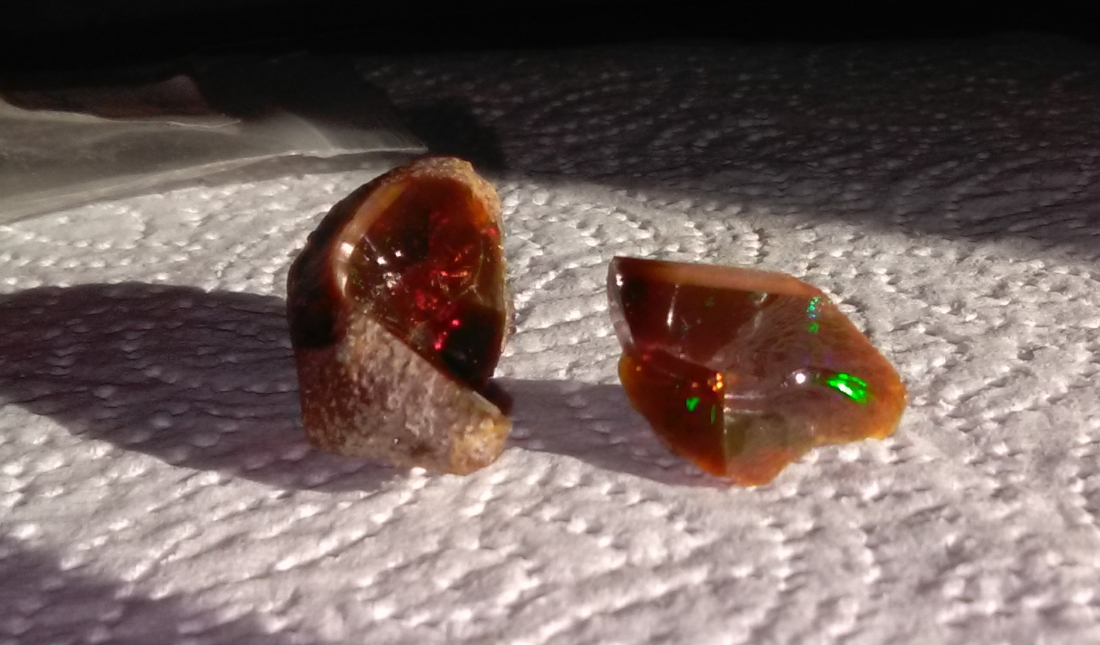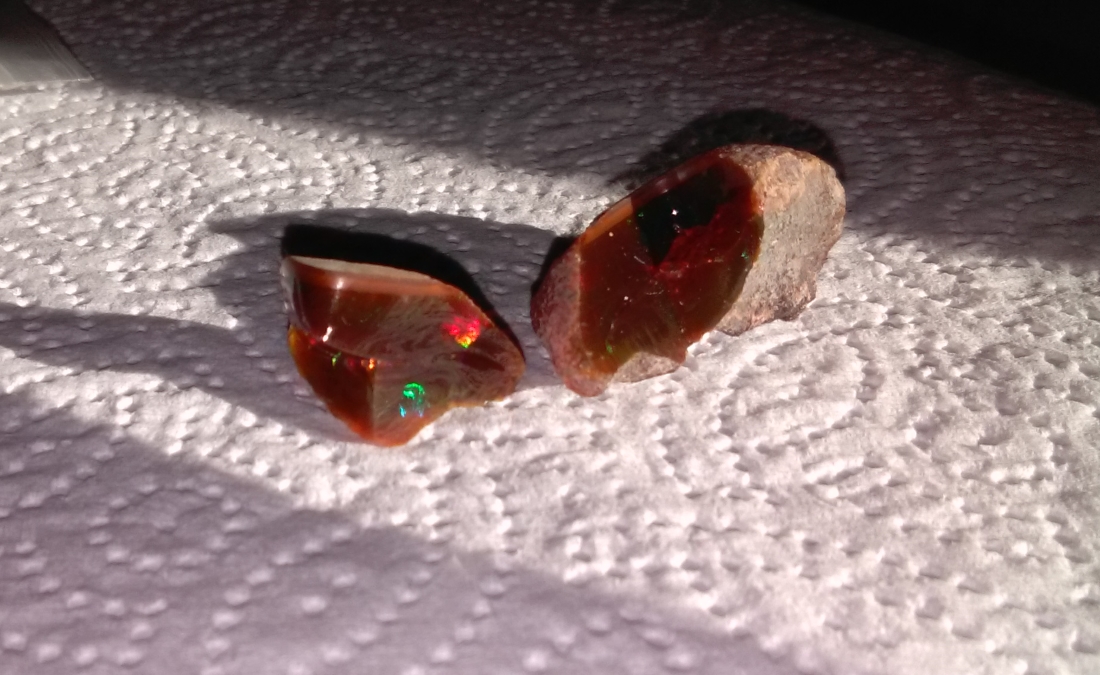|
|
Post by kellykellykelly on Jan 28, 2019 20:15:03 GMT -5
I love opals! I just got a camera phone for now so I apologize if the pics aren't high quality...I just got to wait till I get paid next to get a cord for my Cannon EOS70  . BTW - I have heard azurite is good to practice on before working opals. Does anyone have any experience with cutting and working opals? I'm saving this one till I'm more experienced or let a professional cut and cab it. However I thought I'd post this lovely opal with its firey green glow   |
|
|
|
Post by hummingbirdstones on Jan 28, 2019 20:44:33 GMT -5
There are a few opal cutters here, myself and my husband being two of them. gemfeller and opalpyrexia I'm sure will pop in as soon as they see the thread title.
I thought about letting them chime in first, but just from the chocolate color and the flash in the picture, your opal appears to be the original Shewa Province opal from Ethiopia. Please correct me if I'm wrong. If it is, this type of opal is very cracky and difficult to cut (you can already see some cracks in them. From my experience with them, grinding the rind off of them expedites the opal cracking. I never had any luck with them and have a few still that are left as really pretty specimens in our display case. We knew one guy who cabbed them with the rind on the cabs, and that did seem to keep them more stable.
I'll wait for them to give their opinion.
|
|
gemfeller
Cave Dweller 
Member since June 2011
Posts: 4,060 
|
Post by gemfeller on Jan 28, 2019 21:04:34 GMT -5
I agree completely with Robin on this. The Shewa "chocolate" opals nearly always crack and I know of only one really top cutter who's had some good success with them, though most of his cracked after being cut.
When you're looking for Ethiopian opal try to find the beautiful crystal opal from Welo/Wollo Province. It has its own set of problems being hydrophane, meaning it's "thirsty" and absorbs water rapidly, losing its color-play temporarily until it dries out in a few hours or days. Some of it cracks after it absorbs water but much doesn't. It produces some very beautiful gems.
|
|
|
|
Post by opalpyrexia on Jan 29, 2019 0:55:43 GMT -5
I've never worked with this type of opal so I can't really offer advice specific to it. But given that it's likely to crack further I think that you should just go for it — with or without the rind. In general, perhaps the biggest issue with cutting opal is trying to decide where and with what orientation the best and brightest fire can be exposed. Unless that's relatively obvious, going slowly and very gently with lower grits is advised. I consider 600 to be an aggressive grit for opal. Often I find that I need to make a tradeoff between carat weight, cutting for the best fire and, as always, obtaining a pleasing shape. Best fire usually wins, but not always. I'm sorry about the cracks. That's a big disappointment. I have the last of an older opal parcel dropped and shaped. When I started to cut the best one of the lot it went well until my first examination under magnification. That's when I noticed lots of fine cracks resembling typical crazing.  Fortunately the rest seem to be OK. |
|
|
|
Post by vegasjames on Jan 29, 2019 2:30:37 GMT -5
Never worked with precious opal but from what I have heard when cabbing it you need to be careful to use lots of water to keep it from heating and don't use a lot of pressure.
|
|
|
|
Post by opalpyrexia on Jan 29, 2019 10:43:57 GMT -5
Never worked with precious opal but from what I have heard when cabbing it you need to be careful to use lots of water to keep it from heating and don't use a lot of pressure. I think that is sound, general advice, but my experience has led me to believe that heat is much less of an issue for opal. I dop larger opals on dowels with an Elmers glue. To remove them when finished I put them in a coffee mug of water that's at about 170 degrees and have never damaged one. On the other hand, I wouldn't advise taking an opal out of your freezer and plunging it into boiling water. The smaller ones are dopped on brass rod and removed with my butane torch. Sometimes I'm too slow and the opal has gotten quite hot but never damaged. A couple of months ago I was at it and I must have been sleeping because I yelled and dropped the opal as fast as I could. But I wasn't fast enough! I took a picture of the 2nd degree burn on my index finger from the hot opal. I figure that it must have been close to the boiling point of water for it to burn me so quickly. And, of course, the opal was just fine.
 |
|
gemfeller
Cave Dweller 
Member since June 2011
Posts: 4,060 
|
Post by gemfeller on Jan 29, 2019 11:00:54 GMT -5
opalpyrexia , as you obliquely stated, it's the rate of heating or cooling (expansion/contraction) conthat's dangerous for opals. As you say, you wouldn't plunge a heated opal into ice water. But if heating and cooling are accomplished slowly, opal remains stable -- except for the few that are going to craze no matter what. I use a regular dop station and put my opals on it when it's cold. It's heated with a 100-wat electric bulb so heating is slow. I dop with wax and there's no problem with heating the stones to dop temperature. I've dopped some very expensive opals that way and removed them from the dop in my freezer -- but ONLY after they've cooled again to room temperature.
|
|
|
|
Post by vegasjames on Jan 29, 2019 20:45:24 GMT -5
Never worked with precious opal but from what I have heard when cabbing it you need to be careful to use lots of water to keep it from heating and don't use a lot of pressure. I think that is sound, general advice, but my experience has led me to believe that heat is much less of an issue for opal. I dop larger opals on dowels with an Elmers glue. To remove them when finished I put them in a coffee mug of water that's at about 170 degrees and have never damaged one. On the other hand, I wouldn't advise taking an opal out of your freezer and plunging it into boiling water. The smaller ones are dopped on brass rod and removed with my butane torch. Sometimes I'm too slow and the opal has gotten quite hot but never damaged. A couple of months ago I was at it and I must have been sleeping because I yelled and dropped the opal as fast as I could. But I wasn't fast enough! I took a picture of the 2nd degree burn on my index finger from the hot opal. I figure that it must have been close to the boiling point of water for it to burn me so quickly. And, of course, the opal was just fine.
 Not all opals have the same stability though. There are about 300 types of opal to begin with. Stability and hardness will depend on factors such as aluminum oxide and water contents. |
|
|
|
Post by hummingbirdstones on Jan 29, 2019 21:02:17 GMT -5
Never worked with precious opal but from what I have heard when cabbing it you need to be careful to use lots of water to keep it from heating and don't use a lot of pressure. I think that is sound, general advice, but my experience has led me to believe that heat is much less of an issue for opal. I dop larger opals on dowels with an Elmers glue. To remove them when finished I put them in a coffee mug of water that's at about 170 degrees and have never damaged one. On the other hand, I wouldn't advise taking an opal out of your freezer and plunging it into boiling water. The smaller ones are dopped on brass rod and removed with my butane torch. Sometimes I'm too slow and the opal has gotten quite hot but never damaged. A couple of months ago I was at it and I must have been sleeping because I yelled and dropped the opal as fast as I could. But I wasn't fast enough! I took a picture of the 2nd degree burn on my index finger from the hot opal. I figure that it must have been close to the boiling point of water for it to burn me so quickly. And, of course, the opal was just fine.
 Ouch! I dop with wax normally using an alcohol lamp. I hold my opals above the flame to warm them up and then melt the wax on the stick and shove it on the stone when it's melting. I use the freezer method to remove the stone from the dop. I have never had an opal break on me doing this. |
|
|
|
Post by hummingbirdstones2 on Jan 29, 2019 21:55:25 GMT -5
Hi folks. Time for Mr. Hummingbirdstones (Robin's husband) to catch up with this thread. I've been in front of one saw or another... .
I have a couple of chocolate opal cabs that have been stable for 7-8 years. One is 8x6 or 9x7 - but it started out as big as a ping-pong ball. To me cutting that material is not worth the time and trouble. I think it's prettier as a big flashy chunk of rough.
As for heat, there's another aspect of heat and opal that can cause trouble. Think I killed a couple in the early days by keeping one area of the opal against the wheel for too long. If one part of the rough gets hotter than the rest maybe it expands more than nearby cooler areas. Didn't seem to have that problem after I learned to keep it moving.
As everyone else said, heating (or cooling) opal evenly and gradually during dopping or removing it from the wax isn't a problem. Best thing to do is get some cheap potch-and-color practice rough and grind it to mud until you're comfortable with how it cuts. |
|
|
|
Post by kellykellykelly on Feb 1, 2019 10:30:08 GMT -5
Thanks everyone very much for the much needed advice. I think I will keep this baby in the display case and get better pictures of it.
|
|